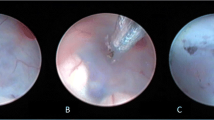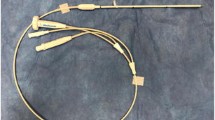Abstract
Introduction
The usage of endoscopic third ventriculostomy (ETV) as an alternative to shunt revision in the management of shunt malfunction is gaining popularity.
Methods
We review the clinical data of 45 patients who underwent ETV because of ventriculopritoneal shunt malfunction at Hacettepe University School of Medicine Department of Neurosurgery between January 2002 and August 2007. Medical records of the patients were retrospectively studied.
Results
Male-to-female ratio was 23/22. The cause of the hydrocephalus was aqueduct stenosis in 21 (46.9%) patients, newborn meningitis in nine (20%) patients, tumor in six (13.3%) patients, newborn intraventricular hemorrhage in four (8.8%) patients, myelomeningocele in three (6.6%), and trauma in two (2.2%) patients. Of the patients, 27 (60%) had triventricular and 18 (40%) had tetraventricular hydrocephalus at their radiologic evaluation. On admission, all patients had at least one episode of shunt dysfunction prior to ETV. Follow-up duration after surgery was 1–5 years (mean 2.46 ± 1.64 years). Postoperative cerebrospinal fluid flow studies using the cine-PC MR imaging were performed on all patients. The overall success rate for ETV after shunt malfunction was 80% with 36 patients and failure rate was 20% with nine patients. All of these nine patients had undergone shunt insertion within 10 days–1 month after unsuccessful ETV.
Conclusion
Endoscopic third ventriculostomy is an effective treatment for shunt malfunction.


Similar content being viewed by others
References
Bargalló N, Olondo L, Garcia AI, Capurro S, Caral L, Rumia J (2005) Functional analysis of third ventriculostomy patency by quantification of CSF stroke volume by using cine phase-contrast MR imaging. AJNR Am J Neuroradiol 26(10):2514–2521
Baskin JJ, Manwaring KH, Rekate HL (1998) Ventricular shunt removal: the ultimate treatment of the slit ventricle syndrome. J Neurosurg 88:478–484
Beems T, Grotenhuis JA (2002) Is the success rate of endoscopic third ventriculostomy age-dependent? An analysis of the results of endoscopic third ventriculostomy in young children. Childs Nerv Syst 18:605–608
Boschert J, Hellwig D, Krauss JK (2003) Endoscopic third ventriculostomy for shunt dysfunction in occlusive hydrocephalus: long-term follow up and review. J Neurosurg 98:1032–1039
Brockmeyer D, Abtin K, Carey L, Walker M (1998) Endoscopic third ventriculostomy: an outcome analysis. Pediatr Neurosurg 28:236–240
Buxton N, Ho KJ, Macarthur D, Vloeberghs M, Punt J, Robertson I (2001) Neuroendoscopic third ventriculostomy for hydrocephalus in adults: report of a single unit’s experience with 63 cases. Surg Neurol 55:74–78
Cinalli G (1999) Alternatives to shunting. Childs Nerv Syst 15:718–731
Cinalli G, Sainte-Rose C, Chumas P, Zerah M, Brunelle F, Lot G, Pierre-Kahn A, Renier D (1999) Failure of third ventriculostomy in the treatment of aqueductal stenosis in children. J Neurosurg 90:448–454
Cinalli G, Salazar C, Mallucci C, Yada JZ, Zerah M, Sainte-Rose C (1998) The role of endoscopic third ventriculostomy in the management of shunt malfunction. Neurosurgery 43(6):1323–1327
Di Rocco C, Marchese E, Velardi F (1994) A survey of the first complication of newly implanted CSF shunt devices for the treatment of nontumoral hydrocephalus. Childs Nerv Syst 10:321–327
Di Rocco C, Massimi L, Tamburrini G (2006) Shunts vs endoscopic third ventriculostomy in infants: are there different types and/or rates of complications. Childs Nerv Syst 22:1573–1589
Drake JM (1993) Ventriculostomy for treatment of hydrocephalus. Neurosurg Clin N Am 4:657–666
Drake JM, Kestle J (1996) Rationale and methodology of the multicenter pediatric cerebrospinal fluid shunt design trial: Pediatric Hydrocephalus Treatment Evaluation Group. Childs Nerv Syst 12:434–447
Drake JM, Kestle JR, Tuli S (2000) CSF shunts: 50 years on past, present and future. Childs Nerv Syst 16:800–804
Epstein F (1985) How to keep shunts functioning, or “the impossible dream”. Clin Neurosurg 32:608–631
Hopf NJ, Grunert P, Fries G, Resch KD, Perneczky A (1999) Endoscopic third ventriculostomy: outcome analysis of 100 consecutive procedures. Neurosurgery 44(4):795–804
Iannelli A, Rea G, Di Rocco C (2005) CSF shunt removal in children with hydrocephalus. Acta Neurochir 147:503–507
Kestle JRW, Walker ML (2005) A multicenter prospective cohort study of the Strata valve for the management of hydrocephalus in pediatric patients. J Neurosurg (Pediatrics) 102:141–145
Koch D, Wagner W (2004) Endoscopic third ventriculostomy in infants of less than 1 year of age: which factors influence the outcome. Childs Nerv Syst 20:405–411
McGirt MJ, Leveque JC, Wellons JC, Villavicencio AT, Hopkins JS, Fuchs HE, George TM (2002) Cerebrospinal fluid shunt survival and etiology of failures: a seven-year institutional experience. Pediatr Neurosurg 36:248–255
Murshid WR (2000) Endoscopic third ventriculostomy: towards more indications for the treatment of non-communicating hydrocephalus. Minim Invasive Neurosurg 43(2):75–82
Nishiyama K, Mori H, Tanaka R (2003) Changes in cerebrospinal fluid hydrodynamics following endoscopic third ventriculostomy for shunt-dependent noncommunicating hydrocephalus. J Neurosurg 98:1027–1031
O’Brien DF, Javadpour M, Collins DR, Spennato P, Mallucci CL (2005) Endoscopic third ventriculostomy: an outcome analysis of primary cases and procedures performed after ventriculoperitoneal shunt malfunction. J Neurosurg 103:393–400
Raimondi AJ (1988) Shunts, indications, problems, and characteristics. Childs Nerv Syst 4:321–324
Robinson S, Kaufman BA, Park TS (2002) Outcome analysis of initial neonatal shunts: does the valve make a difference. Pediatr Neurosurg 37:287–294
Sainte-Rose C, Piatt JH, Renier D, Pierre-Kahn A, Hirsch JF, Hoffman HJ, Humphreys RP, Hendrick EB (1991–1992) Mechanical complications in shunts. Pediatr Neurosurg 17(1):2–9
Schroeder HW, Niendorf WR, Gaab MR (2002) Complications of endoscopic third ventriculostomy. J Neurosurg 96:1032–1040
Schroeder HW, Schweim C, Schweim KH, Gaab MR (2000) Analysis of aqueductal cerebrospinal fluid flow after endoscopic aqueductoplasty by using cine phase-contrast magnetic resonance imaging. J Neurosurg 93(2):237–244
Siomin V, Cinalli G, Grotenhuis A, Golash A, Oi S, Kothbauer K, Weiner H, Roth J, Beni-Adani L, Pierre-Kahn A, Takahashi Y, Mallucci C, Abbott R, Wisoff J, Constantini S (2002) Endoscopic third ventriculostomy in patients with cerebrospinal fluid infection and/or hemorrhage. J Neurosurg 97:519–524
Teo C, Jones R (1996) Management of hydrocephalus by endoscopic third ventriculostomy in patients with myelomeningocele. Pediatr Neurosurg 25:57–63
Tuli S, Drake J, Lawless J, Wigg M, Lamberti-Pasculli M (2000) Risk factors for repeated cerebrospinal shunt failures in pediatric patients with hydrocephalus. J Neurosurg 92:31–38
Author information
Authors and Affiliations
Corresponding author
Rights and permissions
About this article
Cite this article
Bilginer, B., Oguz, K.K. & Akalan, N. Endoscopic third ventriculostomy for malfunction in previously shunted infants. Childs Nerv Syst 25, 683–688 (2009). https://doi.org/10.1007/s00381-008-0779-1
Received:
Published:
Issue Date:
DOI: https://doi.org/10.1007/s00381-008-0779-1




